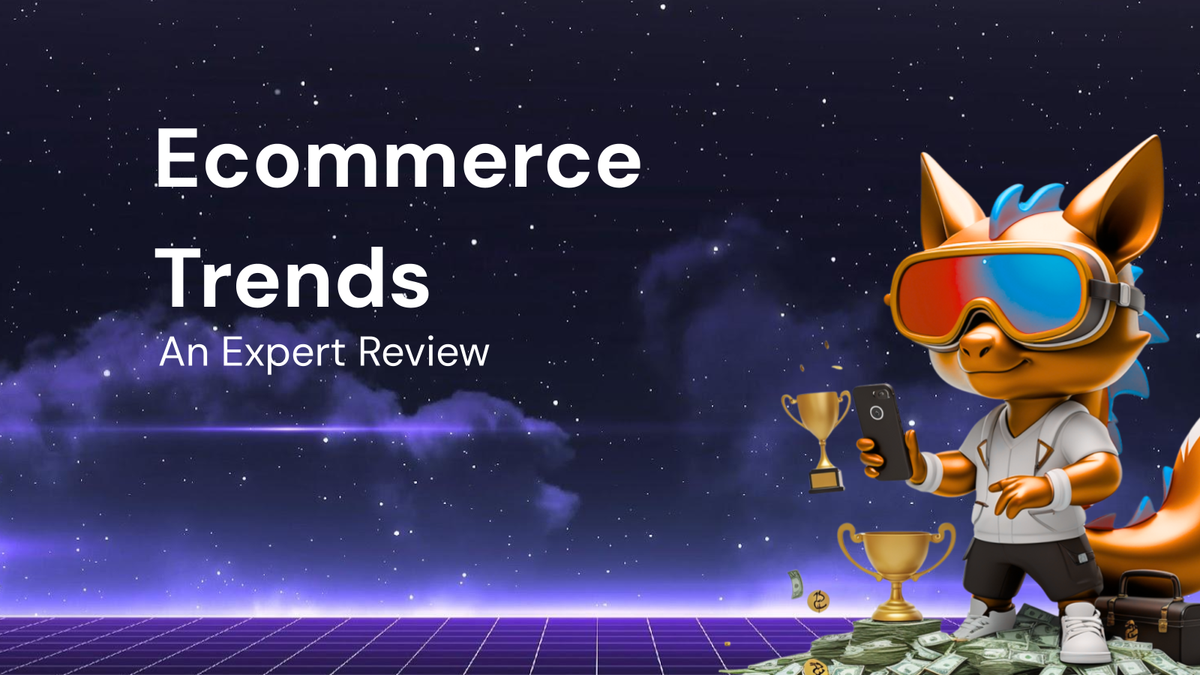What Users Really Want: An Expert Review of Top Ecommerce Trends

What Users Really Want: An Expert Review of Top Ecommerce Trends
The world of ecommerce is in constant flux. New technologies emerge, consumer preferences shift, and what worked yesterday might be obsolete today. Staying ahead of the curve requires a deep understanding of what users really want, beyond just a smooth checkout process and fast shipping. It demands anticipating their needs, catering to their desires, and building experiences that resonate on a personal level.
This expert review dives into the top ecommerce trends shaping the industry, exploring how these trends address core user needs and how businesses can leverage them to create more engaging and profitable online experiences. We'll move beyond superficial observations to uncover the motivations behind these trends, offering actionable insights and practical strategies for implementation.
1. Personalization Beyond Names: Building Truly Customized Experiences
- The Trend: Personalization has been a buzzword for years, but it's moving beyond simple "Hi [Name]" emails. Today, users expect truly customized experiences tailored to their individual preferences, purchase history, browsing behavior, and even contextual factors like location and time of day.
- What Users Really Want:
- Relevance: They want to see products and offers that are actually relevant to their needs and interests. They're tired of being bombarded with generic recommendations that feel impersonal and spammy.
- Efficiency: They want to find what they're looking for quickly and easily. Personalized recommendations and curated product selections streamline the shopping process, saving them time and effort.
- Value: They want to feel like the brand understands them and is offering them special treatment. Personalized discounts, exclusive previews, and personalized content make them feel valued as customers.
- Discovery: They want to be surprised and delighted with new products and experiences they might not have found on their own. Personalization can introduce them to items they never knew they needed.
- How to Implement:
- Data-Driven Segmentation: Collect and analyze data from multiple sources to create detailed customer segments based on demographics, behavior, and preferences.
- AI-Powered Recommendations: Utilize AI algorithms to generate personalized product recommendations based on browsing history, purchase patterns, and real-time behavior.
- Dynamic Content: Serve different content, offers, and layouts to different users based on their individual profiles.
- Personalized Search: Improve search results by factoring in user preferences and past search queries.
- Personalized Email Marketing: Segment email lists and create personalized email campaigns with targeted content and offers.
- Example: Netflix's recommendation engine is a prime example of effective personalization. It uses your viewing history, ratings, and even the time of day you watch to suggest movies and TV shows you might enjoy. This keeps users engaged and coming back for more.
2. The Rise of Social Commerce: Where Discovery Meets Purchase
- The Trend: Social commerce is blurring the lines between social media and ecommerce, allowing users to discover and purchase products directly within their favorite social platforms.
- What Users Really Want:
- Seamless Experience: They want to be able to shop without leaving their favorite social platforms. They are already spending significant time on these platforms, so making the purchase process integrated avoids friction.
- Social Validation: They want to see what their friends and influencers are buying and recommending. Social proof is a powerful motivator, and social commerce provides ample opportunities to discover products through social connections.
- Inspiration: They want to discover new products and brands through visually appealing content and engaging social interactions. Social media is a natural place for inspiration and discovery.
- Convenience: Impulse buys become easier, as the barrier to purchase is lowered.
- How to Implement:
- Leverage Shoppable Posts: Utilize shoppable posts on platforms like Instagram and Facebook to tag products in images and videos, allowing users to purchase directly from the post.
- Integrate Social Media with Your Ecommerce Platform: Ensure your ecommerce platform integrates seamlessly with social media platforms, allowing for easy product sharing and purchase tracking.
- Run Social Media Contests and Giveaways: Increase brand awareness and engagement by running social media contests and giveaways that feature your products.
- Partner with Influencers: Collaborate with influencers to promote your products to their followers and drive traffic to your online store.
- Utilize Social Listening: Monitor social media conversations to identify trends, understand customer sentiment, and respond to customer inquiries.
- Example: Instagram Shopping is a leading example of social commerce. Users can browse products tagged in photos and videos, and then purchase them directly within the app.
3. Embracing Augmented Reality (AR) and Virtual Reality (VR): Experiential Shopping Takes Center Stage
- The Trend: Augmented Reality (AR) and Virtual Reality (VR) are transforming the shopping experience by allowing users to visualize products in their own environment or immerse themselves in a virtual store.
- What Users Really Want:
- Confidence: They want to be confident that the products they're buying will fit their needs and preferences. AR and VR provide a more realistic and interactive way to visualize products before making a purchase, reducing the risk of returns.
- Engagement: They want to be entertained and engaged while shopping. AR and VR can create immersive and memorable shopping experiences that go beyond traditional browsing.
- Convenience: They want to try before they buy, but without leaving their homes. AR and VR offer a convenient way to "try on" clothes, "place" furniture in their living room, or "test drive" a car without visiting a physical store.
- Information: AR can overlay important product information on the real-world view, such as measurements, material, or installation instructions.
- How to Implement:
- AR Product Visualization: Allow users to visualize products in their own environment using their smartphone or tablet camera.
- VR Virtual Store Tours: Create virtual store tours that allow users to explore your products and browse your inventory in a 3D environment.
- AR Try-On Experiences: Enable users to virtually try on clothes, accessories, or makeup using AR technology.
- Product Configurators: Allow users to customize products in real-time using AR or VR, seeing how different colors, materials, and features will look.
- Example: IKEA Place allows users to virtually place furniture in their homes using AR. This helps them visualize how the furniture will look in their space and ensures that it fits their needs.
4. The Power of Voice Commerce: Making Shopping Effortless
- The Trend: Voice commerce is on the rise, driven by the increasing popularity of smart speakers and voice assistants. Users are using their voices to search for products, place orders, and track shipments.
- What Users Really Want:
- Convenience: They want to be able to shop hands-free and eyes-free, while multitasking or on the go. Voice commerce allows them to do this with simple voice commands.
- Speed: They want to complete tasks quickly and efficiently. Voice commands are often faster than typing or navigating through menus.
- Simplicity: They want a simple and intuitive way to interact with brands. Voice interfaces are often more natural and intuitive than traditional interfaces.
- Accessibility: Voice commerce can be particularly beneficial for users with disabilities who may have difficulty using traditional interfaces.
- How to Implement:
- Optimize Your Website for Voice Search: Use natural language keywords and phrases in your product descriptions and website content.
- Integrate with Voice Assistants: Make your products and services available through popular voice assistants like Amazon Alexa and Google Assistant.
- Create Voice-Activated Apps: Develop voice-activated apps that allow users to browse your products, place orders, and track shipments.
- Offer Voice-Based Customer Support: Provide voice-based customer support through voice assistants or chatbots.
- Example: Amazon Alexa allows users to order products directly from Amazon using voice commands. This makes it incredibly convenient to reorder frequently purchased items.
5. Sustainability and Ethical Consumption: Shopping with a Conscience
- The Trend: Consumers are increasingly concerned about the environmental and social impact of their purchases. They are seeking out brands that are committed to sustainability, ethical sourcing, and fair labor practices.
- What Users Really Want:
- Transparency: They want to know where their products come from and how they are made. They want to be confident that the brands they are supporting are operating ethically and sustainably.
- Authenticity: They want to support brands that are genuinely committed to sustainability and ethical practices, not just greenwashing.
- Impact: They want their purchases to make a positive impact on the environment and society. They want to feel like they are contributing to a better world.
- Options: They want access to sustainable and ethical alternatives to traditional products.
- How to Implement:
- Be Transparent About Your Supply Chain: Provide detailed information about your supply chain, including where your products are sourced, how they are made, and the labor practices involved.
- Embrace Sustainable Materials and Practices: Use sustainable materials and manufacturing processes whenever possible.
- Partner with Ethical Organizations: Support organizations that are working to promote sustainability and ethical labor practices.
- Communicate Your Sustainability Efforts: Clearly communicate your sustainability efforts to your customers through your website, social media, and marketing materials.
- Offer Eco-Friendly Packaging and Shipping Options: Provide customers with eco-friendly packaging and shipping options.
- Example: Patagonia is a leading example of a brand that is committed to sustainability and ethical practices. They use recycled materials in their products, promote fair labor practices, and donate a portion of their profits to environmental causes.
6. Subscription Commerce: Building Loyalty and Recurring Revenue
- The Trend: Subscription commerce continues to grow, offering users convenience, value, and personalized experiences. From meal kits to beauty boxes, subscription services are becoming increasingly popular.
- What Users Really Want:
- Convenience: They want to have products delivered to their doorstep on a regular basis, without having to worry about reordering.
- Value: They want to receive a good value for their money, whether it's through discounted pricing, exclusive products, or personalized recommendations.
- Discovery: They want to discover new products and brands through curated subscription boxes.
- Personalization: They want subscription services that are tailored to their individual needs and preferences.
- Control: They want the flexibility to pause, cancel, or customize their subscriptions at any time.
- How to Implement:
- Offer a Variety of Subscription Options: Provide customers with a range of subscription options to choose from, based on their needs and preferences.
- Personalize the Subscription Experience: Tailor the products and content included in the subscription box to each individual customer.
- Provide Exclusive Value: Offer subscribers exclusive discounts, early access to new products, and other perks.
- Make it Easy to Manage Subscriptions: Provide customers with a user-friendly interface for managing their subscriptions, including the ability to pause, cancel, or customize their orders.
- Focus on Building Relationships: Engage with your subscribers regularly through email, social media, and other channels to build strong relationships and foster loyalty.
- Example: Netflix is a prime example of a successful subscription service. They provide users with access to a vast library of movies and TV shows for a monthly fee.
7. Mobile-First Experiences: Optimizing for the Small Screen
- The Trend: With the majority of online shopping now happening on mobile devices, it's crucial to provide a seamless and optimized mobile experience. This means designing websites and apps that are fast, responsive, and easy to use on smartphones and tablets.
- What Users Really Want:
- Speed: They want websites and apps that load quickly and respond instantly to their actions.
- Responsiveness: They want websites and apps that adapt seamlessly to different screen sizes and devices.
- Ease of Use: They want websites and apps that are easy to navigate and use, with clear calls to action and intuitive interfaces.
- Convenience: They want to be able to shop on the go, from anywhere and at any time.
- How to Implement:
- Use a Responsive Website Design: Ensure your website is responsive and adapts seamlessly to different screen sizes and devices.
- Optimize Images and Videos: Optimize images and videos for mobile devices to reduce file sizes and improve loading speeds.
- Simplify Navigation: Simplify navigation on your mobile website or app, making it easy for users to find what they're looking for.
- Use Large, Clear Buttons: Use large, clear buttons that are easy to tap on a mobile device.
- Offer Mobile Payment Options: Provide customers with a variety of mobile payment options, such as Apple Pay and Google Pay.
- Example: ASOS has a highly optimized mobile app that provides a seamless shopping experience on smartphones and tablets.
Conclusion: Focus on the User, and Success Will Follow
The ecommerce landscape is constantly evolving, but one thing remains constant: the importance of understanding and meeting the needs of your users. By focusing on personalization, social commerce, AR/VR, voice commerce, sustainability, subscription services, and mobile-first experiences, you can create online shopping experiences that are engaging, convenient, and valuable for your customers.
Remember, the key to success in ecommerce is not just about selling products, it's about building relationships with your customers and providing them with experiences that they will remember and appreciate. By staying ahead of the curve and focusing on what users really want, you can create a thriving online business that is built to last. Continual monitoring of trends, analyzing customer data, and a willingness to adapt are all crucial for long-term success in the dynamic world of ecommerce.




